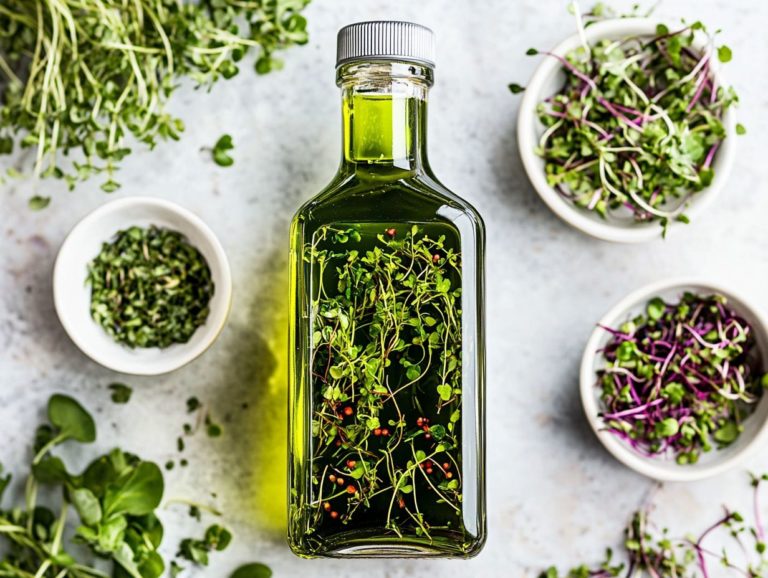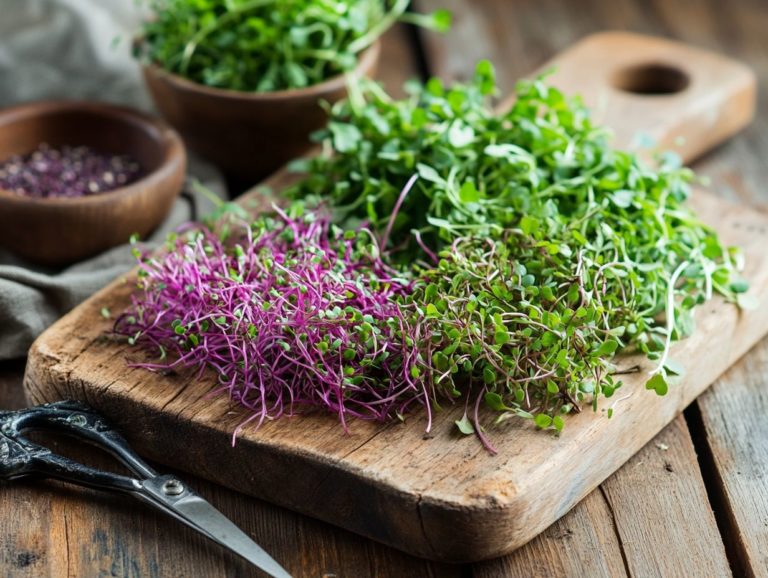97. 5 Ways to Enjoy Microgreens at Breakfast
Microgreens are more than just a trendy garnish; they re a powerhouse of flavor and nutrients that can truly elevate your breakfast experience. If you re aiming to enhance your morning omelette or seeking to give your avocado toast a refreshing twist, these tiny greens present endless possibilities.
This article delves into five delicious ways to incorporate microgreens into your breakfast routine, complete with insights into their benefits, tips for growing your own, and nutritional comparisons. Get ready to transform your mornings with these vibrant and healthy additions!
Contents
- Key Takeaways:
- 1. Add Them to Your Omelette
- 2. Sprinkle Them on Top of Avocado Toast
- 3. Use Them as a Garnish for Smoothie Bowls
- 4. Incorporate Them Into Your Breakfast Sandwich
- 5. Mix Them Into Your Breakfast Bowl
- What Are Microgreens and Why Are They Beneficial?
- Frequently Asked Questions
- 1. What exactly are microgreens and why are they a great addition to my breakfast?
- 2. How do I incorporate microgreens into my breakfast?
- 3. Are there specific types of microgreens that work best in breakfast dishes?
- 4. Can I grow my own microgreens at home?
- 5. Are there any health benefits to eating microgreens at breakfast?
- 6. Can I add microgreens to my breakfast even if I’m not a fan of vegetables?
Key Takeaways:

- Boost your breakfast with a nutritious punch by incorporating microgreens into your morning routine.
- Get creative with microgreens by adding them to your favorite breakfast dishes, such as omelettes, avocado toast, smoothie bowls, and breakfast sandwiches, with recipe ideas for every palate.
- Take advantage of the health benefits of microgreens, including their high nutrient content and easy at-home growing process.
1. Add Them to Your Omelette
Incorporating microgreens into your omelette not only elevates the flavor but also offers a nutritional boost. These vibrant greens add color and texture. They turn a simple dish into a delicious meal packed with health benefits like vitamins and minerals.
Popular varieties include arugula, which delivers a peppery punch, curly pea that offers a tender crunch, and nutrient-rich broccoli microgreens brimming with vitamins.
To craft the perfect omelette, think about lightly saut ing onion slices and adding a hint of grated ginger for an aromatic kick. Then fold in your microgreens just before serving to preserve their delicate nutrients, ensuring you enjoy all the benefits.
Pairing these greens with ingredients like feta cheese or cherry tomatoes can elevate the flavor profile, resulting in a deliciously balanced meal. A light squeeze of lemon juice enhances freshness.
2. Sprinkle Them on Top of Avocado Toast
Sprinkling microgreens on your avocado toast elevates this trendy dish, offering a delightful combination of flavors and added nutritional benefits. Imagine adding sunflower sprouts, with their mild yet nutty flavor, providing the perfect counterpoint to the creamy richness of the avocado.
Then, toss in some radish microgreens and spicier microgreens for a peppery kick that awakens your taste buds. These vibrant greens not only enhance the dish’s aesthetic appeal but also boost its overall health profile.
For a refreshing twist, drizzle a bit of lemon juice and a hint of garlic over the greens to elevate the flavor experience even further. This transforms a simple avocado toast into a nutrient-dense delight that s satisfying and bursting with flavor.
3. Use Them as a Garnish for Smoothie Bowls
Using microgreens as a garnish for your smoothie bowls adds a visually stunning touch while infusing your breakfast with fresh nutrition. This elevates both flavor and health benefits, making them perfect for microgreens smoothies.
By thoughtfully selecting the right microgreens to pair with your smoothie flavors, you can enhance the overall taste profile while maximizing the health advantages. For instance, bold and peppery microgreens like radish can introduce a delightful spiciness to your fruit-heavy smoothie bowls.
Blending microgreens directly into your smoothie creates a seamless texture and boosts nutrient content, ensuring each spoonful is packed with flavor. Balancing these bold tastes with sweeter fruits guarantees a harmonious and delicious breakfast experience that you ll look forward to every morning.
Try these microgreens tips today and elevate your breakfast game!
4. Incorporate Them Into Your Breakfast Sandwich

Incorporating microgreens into your breakfast sandwich can elevate this classic meal. They add a fresh and exciting element that pairs beautifully with ingredients like tempeh and fresh avocado.
These tiny greens provide a vibrant splash of color and a variety of flavors. For instance, layering microgreens with roasted beets creates a delightful contrast between the earthiness of the beets and the peppery notes of the greens.
You can also add slices of heirloom tomato or creamy goat cheese to enrich the flavor. Such combinations turn an ordinary breakfast sandwich into a gourmet delight.
5. Mix Them Into Your Breakfast Bowl
Mixing microgreens into your breakfast bowl turns it into a nutrient-dense meal. It satisfies your palate while supporting a healthy lifestyle.
Picture starting the morning with creamy oatmeal, topped with vibrant microgreens, a hint of grated ginger, and a light squeeze of lemon juice. You could also have a quinoa base adorned with roasted sweet potatoes and spicy arugula.
If you’re craving something heartier, try a warm dish with saut ed vegetables and grains, topped with fresh microgreens. This not only boosts the nutritional value but also makes your meal visually appealing.
By layering these elements, each bite becomes a delightful interplay of tastes and textures, setting a positive tone for your day.
What Are Microgreens and Why Are They Beneficial?
Microgreens are tiny, vibrant greens harvested just after the first leaves appear. They are a nutritional powerhouse, adding value to any meal.
Packed with vitamins, minerals, and antioxidants, these small wonders have gained attention from health organizations like the CDC and USDA. They highlight the importance of including them in a balanced diet.
These nutrient-dense gems are usually grown from seeds like arugula, kale, and beet. They thrive in various environments, requiring minimal space and resources.
The growing process is straightforward: sow the seeds in soil, provide light, and within a week or two, they re ready for your table. Each variety brings its own distinct flavor and culinary potential.
Thanks to their high concentrations of essential nutrients, microgreens can support heart health, boost your immune system, and aid digestion. They are an outstanding choice for anyone embracing a vegan or vegetarian lifestyle.
How Can Microgreens Be Grown at Home?
Growing microgreens at home is rewarding and simple. You can enjoy the freshest greens right from your kitchen.
Imagine enhancing your meals with vibrant, nutritious ingredients that can easily be sourced from health food stores or farmers markets.
To start, select the right container. Your options might include shallow trays or even repurposed plastic containers. It s essential to use well-draining soil, as good moisture retention will set the stage for optimal growth conditions for your seeds.
A bright, sunny windowsill or a grow light will provide the necessary light exposure to support robust plant development.
Opt for popular choices like radish, basil, and sunflower microgreens. These are easy to grow and deliver a remarkable flavor punch.
With attentive care in watering and proper spacing, these little greens will flourish, leading to lots of greens ready to elevate your salads, sandwiches, and smoothies.
What Are the Different Types of Microgreens?

The world of microgreens offers an impressive array of varieties, each with unique flavors and health benefits. From the peppery punch of arugula to the sweet crunch of sunflower sprouts, you ll find endless culinary possibilities.
These tiny greens are typically harvested just after their first real leaves appear, infusing your dishes with vibrant colors and intriguing textures.
For example, radish microgreens bring a zesty kick that can elevate your sandwiches and add a delightful twist to salads. Pea shoots, with their sweet and tender nature, are perfect for tossing into stir-fries or using as a garnish for vegetable platters.
Then there are beet greens, which offer a stunning hue and a subtle earthy sweetness, making them a fantastic choice for saut ed side dishes with garlic. Each type adds its own character to your meals, transforming your culinary creations into something truly special.
How Do Microgreens Compare to Other Greens in Terms of Nutrition?
When you compare microgreens to other leafy greens, it becomes clear that microgreens often deliver a more concentrated nutritional punch. They offer higher levels of vitamins, minerals, and antioxidants, significantly enhancing the nutritional profile of any dish.
For instance, a study from the USDA has shown that red cabbage microgreens can contain up to 40 times more vitamin E than their mature counterparts, positioning them as a true powerhouse of nutrition.
Incorporating microgreens into your meals enhances flavor and amplifies health benefits as well, making them a smart choice for the health-conscious.
Whether you toss them into a vibrant salad, use them as a garnish for grilled fish, or blend them into a creamy soup, microgreens easily outshine traditional leafy greens.
They provide a delicate texture and a concentrated dose of nutrients that can enhance your overall dietary quality.
What Are Some Other Ways to Incorporate Microgreens into Meals?
Incorporating microgreens into your meals transcends the usual salad routine. They can be creatively woven into a variety of dishes, enhancing both flavor and nutrition, while effortlessly elevating your culinary skills with vibrant, uncomplicated recipes.
Picture this: tossing them into a warm stir-fry, where their light crunch provides a delightful contrast to tender vegetables. Or imagine blending them into a refreshing smoothie, giving it an invigorating burst of nutrients.
These tiny greens can also act as stunning garnishes for soups and entrees, adding an appealing visual touch. When paired with ingredients like ginger and garlic, their natural zest truly shines.
A drizzle of balsamic glaze introduces a rich depth, especially when complemented by roasted veggies.
The versatility of microgreens unlocks a realm of flavorful possibilities in your everyday meals. Start your garden today and experience the joy of fresh microgreens!
Are There Any Precautions to Keep in Mind When Consuming Microgreens?
While microgreens boast an array of health benefits, it s crucial to know certain precautions to ensure safe consumption, as advised by health authorities like the CDC, especially regarding sourcing (where you buy them) and cleanliness (how clean they are).
These young, nutrient-dense plants can be susceptible to contamination if not handled properly. Choose microgreens from reputable health food stores or trusted farmers markets. This not only supports local agriculture but also ensures that your produce has been safely grown.
In terms of preparation, be sure to wash your microgreens thoroughly under running water and gently pat them dry with a clean towel before diving in. Utilizing clean utensils and surfaces while handling microgreens further minimizes the risk of illness from contaminated food, transforming these vibrant greens into a delicious and safe addition to your diet.
Watch this quick guide on using microgreens in meals!
Frequently Asked Questions

1. What exactly are microgreens and why are they a great addition to my breakfast?
Microgreens are tiny seedlings of vegetables and herbs that are packed with nutrients and flavor. They are usually harvested within 7-14 days of sprouting and are known for their high concentration of vitamins, minerals, and antioxidants. Adding microgreens to your breakfast can give you an extra boost of nutrition to start your day off right.
2. How do I incorporate microgreens into my breakfast?
There are countless ways to enjoy microgreens at breakfast! You can top your toast or bagel with them, add them to your omelette or breakfast burrito, blend them into your smoothie, or even sprinkle them on your yogurt or oatmeal. You can get creative with them!
3. Are there specific types of microgreens that work best in breakfast dishes?
While all microgreens are nutritious, some varieties are more suited for breakfast dishes than others. Broccoli, kale, and radish microgreens are great options for adding a crunchy texture to your breakfast, while cilantro and basil microgreens can provide a burst of fresh flavor.
4. Can I grow my own microgreens at home?
Absolutely! Growing your own microgreens at home is not only cost-effective, but it also ensures that you are getting the freshest and most nutrient-dense greens possible. All you need is a container, some potting soil, and seeds. You can find plenty of tutorials online for growing microgreens at home.
5. Are there any health benefits to eating microgreens at breakfast?
Yes, there are many health benefits to incorporating microgreens into your breakfast. They are packed with vitamins and minerals, can aid in digestion, and may even help boost your immune system. Plus, they add a delicious and colorful touch to your breakfast plate.
6. Can I add microgreens to my breakfast even if I’m not a fan of vegetables?
Definitely! Microgreens have a milder flavor compared to their mature counterparts, making them a great option for those who are not big fans of vegetables. Plus, they can easily be hidden in dishes like smoothies or omelettes, so you can still reap the nutritional benefits without even noticing them!






